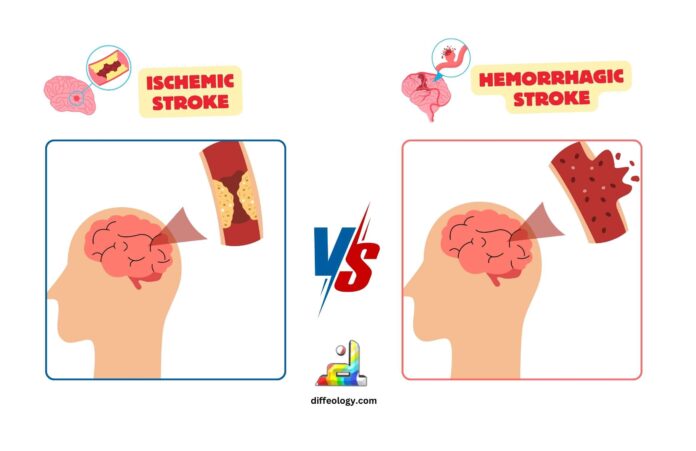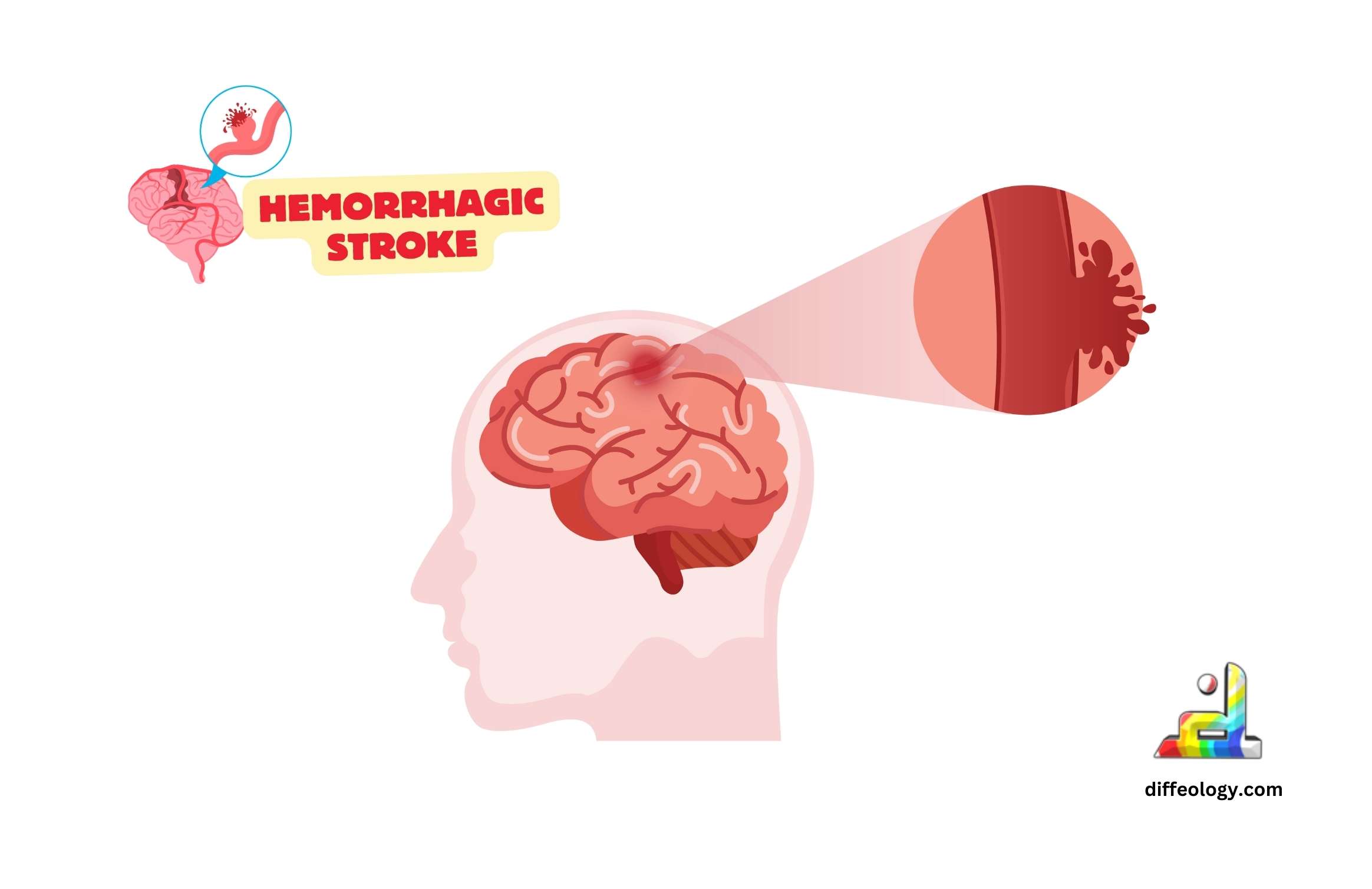There are actually two major types of strokes: ischemic and hemorrhagic. Each type affects the brain but occurs differently. There is a huge difference between ischemic and hemorrhagic stroke. Ischemic strokes are caused by the blockage of one of the blood vessels in the brain, which in most cases is formed by a blood clot. This blocks blood flow to the brain cells, which may cause damage.
Ischemic strokes constitute 87% of all strokes. Hemorrhagic strokes occur when a blood vessel in the brain ruptures, and this causes bleeding in the brain. The blood flow exerts pressure on the brain cells and leads to their damage. Hemorrhagic strokes are less common but fatal. Knowing the difference makes a difference since they require different treatments.
Main Difference Between Ischemic and Hemorrhagic Stroke
An ischemic stroke is due to obstruction in an artery to the blood supply of the brain, usually caused by a blood clot. Hemorrhagic strokes are those cases wherein there is some sort of rupture in the blood vessel, and the blood escapes into the brain.
High cholesterol and fatty deposition inside the arteries are the principal risk factors for ischemic strokes, but high blood pressure is the most common cause of hemorrhagic strokes. In ischemic strokes, cells in the brain are broken because of insufficient oxygen supply and nutrients. In hemorrhagic strokes, pressure from bleeding can also damage the tissues in the brain.
Ischemic Stroke Vs. Hemorrhagic Stroke
What is Ischemic Stroke?
Ischemic stroke is that stroke type wherein the blood supply to part of the brain is cut off. This is the most common form of stroke and also the one responsible for an estimated 87% of all strokes. A blood clot or a fatty deposit most commonly causes the blockage, lodged in a blood vessel in the brain. When this occurs, the cells of the portion of the brain do not get enough oxygen and nutrients to survive, and the cells die. This happens very quickly, causing permanent damage to the brain if not treated right away.
Common signs of an ischemic stroke include weakness on one side of the body, confusion, difficulty speaking, or numbness in one arm or leg. Ischemic strokes can be very life-threatening and can cause death.
Read Also: Difference Between Arteries and Veins
The longer the brain tissue goes without oxygen, the more damage will occur. In reality, 1 in 6 people worldwide will experience a stroke sometime during their lives. Because stroke treatment must take place rapidly in order to prevent significant brain damage, identification of symptoms is necessary. Doctors may prescribe some drugs that may help break down the blood clot, or they may have to operate to remove the blood clot.
Some patients will even regain their full recovery after having a stroke, while in other cases, permanent impairments can arise, such as in movement, speaking, or thinking. This is why knowing how to react in the event of a stroke is crucial, especially seeking help right away. What is Hemorrhagic Stroke?
What is Hemorrhagic Stroke?
A hemorrhagic stroke is a condition where there is bleeding within the brain due to the rupture of a blood vessel. This causes internal bleeding or blood leaking in or around the brain. If this occurs, there is not enough oxygen and nutrients to the brain cells; consequently, damage occurs to the brain. Hemorrhagic strokes are less common than other forms of strokes, accounting for about 13% of total stroke cases; however, they are highly fatal.
Read Also: Difference Between Stent and Stint
The primary cause of stroke is high blood pressure, trauma, or weak vessels. It can also result from an aneurysm, in which a part of a blood vessel is inflated and bursts. The two forms of hemorrhagic stroke occur either as an intracerebral hemorrhage or a subarachnoid hemorrhage.
In intracerebral hemorrhage, the bleeding is inside the brain. Subarachnoid hemorrhage is described as bleeding that occurs between the brain and the thin tissues covering it. In hemorrhagic stroke, symptoms include sudden severe headaches, nausea, confusion, and weakness in parts of the body. Surgery to cut off the bleeding and reduce pressure against the brain is often the treatment for hemorrhagic stroke.
Comparison Table “Ischemic Stroke Vs. Hemorrhagic Stroke”
| Cause | Blocked blood flow | Burst blood vessel |
| Blood Clot | Yes | No |
| Bleeding | No | Yes |
| Brain Damage | Lack of oxygen | Pressure from blood |
| Occurrence | More common | Less common |
| Risk Factors | High blood pressure, cholesterol | High blood pressure, weak blood vessels |
| Symptoms | Sudden weakness | Severe headache |
| Loss of Speech | Common | Less common |
| Confusion | Frequent | May occur |
| Severe Headache | Rare | Very common |
| Treatment | Clot-busting drugs | Surgery to stop bleeding |
| Recovery Time | Varies, but often longer | Varies, but often shorter |
| Risk of Death | Lower | Higher |
| Survival Rate | Higher | Lower |
| Preventable | Mostly | Less easily |
| Medical Emergency | Yes | Yes |
| Blood Pressure Link | Strong link | Strong link |
| Affects the Brain | Lack of oxygen | Blood builds up |
| Long-term Disability | Possible | Likely |
| Medical Intervention | Critical | Critical |
Difference Between Ischemic and Hemorrhagic Stroke in Detail
Get to know the Difference Between Ischemic Stroke Vs. Hemorrhagic Stroke in Detail.
What Caused Stroke
Stroke can be broadly categorized into two types: ischemic and hemorrhagic. In the case of an ischemic stroke, the brain receives a blood clot that interrupts the blood flow to it, preventing oxygen and nutrients from being passed to the cells, leading to their death. It is estimated that about 87% are ischemic.
A hemorrhagic stroke occurs when a blood vessel inside your head is enlarged or ruptures; this causes bleeding in the brain. This then damages the brain cells and also increases the pressure inside your head. More dangerous, although not as common (about 13% of strokes), hemorrhagic strokes are more dangerous.
Causes and Risk Factors
Blood circulation problems are the cause of most ischemic strokes. These include high blood pressure, high cholesterol, and diabetes. Smoking and obesity may increase such factors as the narrowing of the arteries.
Some conditions cause hemorrhagic strokes, such as high blood pressure that doesn’t control, aneurysms, or brain injuries. They can also be caused by conditions in the blood or on blood-thinning medications. The use of drugs like cocaine can contribute to this type of stroke.
Symptoms
Both forms of strokes will share similar symptoms, but some are distinct between the two. Symptoms of ischemic strokes can be abrupt, as well as weakness on one side, trouble speaking, dizziness, and headaches that are severe.
Hemorrhagic strokes are said to have an onset that can be more extreme and sometimes a combination of these symptoms: sudden severe headaches, nausea, and unconsciousness; in extreme cases, where the bleeding causes swelling in the brain, confusion, seizures, and even coma. The worse the symptoms are, the faster the bleeding will be.
Treatment Methods
Treating the two types of strokes, one very different from the other. With regard to the ischemic type, the task is to restore blood flow as quickly as possible. Drugs may be administered to dissolve clots, or devices may be used to remove clots.
In hemorrhagic strokes, treatments will target the immediate stop of bleeding. A ruptured blood vessel may be surgically fixed and collected blood evacuated. Medications can also be administered to decrease blood pressure or reverse blood thinners.
Recovery and Rehabilitation
Recovery from a stroke may be more challenging for both, although the chances of recovery differ. Patients suffering from an ischemic stroke generally recover much better and, quite often, much faster as well. They will most likely undertake physical, speech, and occupational therapy to improve the recovery process. Most can learn everything that has been lost.
Hemorrhagic strokes tend to recover more slowly and more painfully. Such bleeding damage may be severe, leading to many long-term issues such as paralysis, amnesia, or other problems in movements. Some patients require lifelong care and lower survival rates.
Complications
While complications of a stroke are serious, it is very interesting to note that strokes can be classified into two types. Ischemic strokes often cause permanent damage to the brain, which hampers certain normal functions and includes paralysis, vision issues, and speech or even memory problems. If not properly treated, the chances are very high of having another ischemic stroke.
More serious complications may occur with hemorrhagic strokes, like elevated intracranial pressure commensurate with the hemorrhage, which could require surgical intervention. Survivors have risks for seizures or even secondary hemorrhage in the brain.
Prognosis
Overall, the outlook of ischemic stroke patients is much more benign than that of hemorrhagic stroke patients. Approximately 75% of ischemic stroke patients survive at least a year, and most can regain their independent capacity to carry out daily activities, provided early treatment is given.
Hemorrhagic strokes, on the other hand, entail a much higher mortality rate. Patients undergoing hemorrhagic stroke treatment die about 40-50% within the first month. Those who do survive usually suffer from extreme disabilities and require extensive rehabilitation because the bleeding can rapidly damage important parts of the brain.
Key Points Showing the Difference Between Ischemic and Hemorrhagic Stroke
Onset of Symptoms
Symptoms of an ischemic stroke may develop more slowly over time, while hemorrhagic strokes can cause sudden and severe symptoms, like a sudden headache.
Treatment Approach
Ischemic strokes are usually treated with medications that dissolve clots and restore blood flow. Hemorrhagic strokes need surgery to stop the bleeding and reduce pressure on the brain.
Mortality Rate
Hemorrhagic strokes tend to have a higher mortality rate than ischemic strokes because of the severe damage caused by bleeding.
Recovery Outcome
People recovering from ischemic strokes often have better long-term outcomes compared to hemorrhagic stroke survivors, who may face more complications.
Common Age Group
Both types of strokes usually happen in older adults, but hemorrhagic strokes can also affect younger people, especially those with certain conditions like aneurysms.
Blood Vessel Condition
In ischemic strokes, the arteries may become narrow or blocked over time due to buildup. In hemorrhagic strokes, the blood vessels burst suddenly, often from weakness in the vessel walls.
Speed of Medical Attention
Both types require quick medical attention, but ischemic strokes can sometimes be treated within a few hours using clot-busting drugs, while hemorrhagic strokes often need immediate surgery.
Effect on the Brain
Ischemic strokes primarily affect brain function by cutting off oxygen, while hemorrhagic strokes cause damage both from lack of oxygen and the pressure of the blood pooling in the brain.
Use of Medications
Blood-thinning medications can help prevent ischemic strokes by reducing clot formation, but these medicines can increase the risk of hemorrhagic strokes by making bleeding worse.
Risk of Recurrence
Both stroke types can happen again, but lifestyle changes and medications can significantly reduce the chance of ischemic stroke recurrence. Hemorrhagic stroke risk is harder to control unless underlying conditions like high blood pressure are treated.
FAQs: Ischemic Stroke Vs. Hemorrhagic Stroke
Conclusion
Ischemic strokes are often preventable through managing risk factors like cholesterol, diet, and exercise. Hemorrhagic strokes require control of blood pressure and avoidance of head injuries or blood vessel abnormalities. Hemorrhagic strokes are more commonly linked to aneurysms, which are bulges in blood vessels that can burst and cause bleeding in the brain.
After an ischemic stroke, patients often need physical therapy to regain lost functions. Hemorrhagic stroke recovery might include more complex surgeries and a longer rehabilitation period. Ischemic strokes are more common, accounting for about 85% of stroke cases, while hemorrhagic strokes are less common but more deadly. So, here is the Difference Between Ischemic and Hemorrhagic Stroke.



